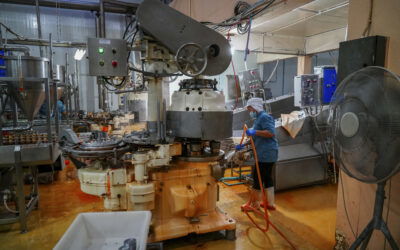The illusion of good overall equipment effectiveness
“Our OEE is excellent we’re at 78%.”
We hear this often. Plant managers showing us their spreadsheets, confident in their numbers. Until we install sensors and start measuring for real. Then that 78% drops to 58%. This isn’t uncommon. A global rubber processing company, supplier to automotive and aeronautical manufacturers, had no accurate overview of their equipment’s performance. After implementing PerfTrak, they discovered their real OEE was just 47% far below what they estimated. Within three months of understanding their actual performance losses, they increased it to 72%.
Hidden OEE losses are the silent killers of manufacturing productivity. These performance losses remain invisible in manual tracking systems, creating a dangerous illusion of equipment effectiveness. Most factories experience 15–20% productivity loss they cannot see, directly impacting productivity and profitability and operational efficiency. The problem isn’t just low overall equipment effectiveness it’s measuring the wrong OEE data entirely.
What equipment effectiveness doesn’t show you
Here’s the uncomfortable truth: overall equipment effectiveness is only as accurate as the data you feed it. Most manual tracking systems miss the performance losses that matter most. Operators fill out downtime logs during breaks, remembering the big stops but missing everything else. This creates massive gaps in OEE data that distort your entire understanding of production efficiency.
Availability losses and unplanned downtime
A jam clears itself. A sensor hiccups. The conveyor pauses for 5 seconds. These micro-stops happen 50, 70, sometimes 100 times per shift. Each one feels insignificant. Together, they represent catastrophic availability losses. 14% of production time can be lost to micro-stops that’s 67 minutes of invisible unplanned downtime. No operator writes down a 4-second stop, but when it happens every 8 minutes throughout the manufacturing process, the production output impact is devastating.
Performance losses from reduced speed
Your production line is rated for 100 parts per minute. Today it’s running at 83. Why? Maybe worn equipment. Maybe inconsistent material feed. Maybe gradual degradation no one noticed. Reduced speed losses are invisible to the naked eye. You can’t feel the difference between 100/min and 85/min just by watching, but over 8 hours, that’s 7,200 missing parts a massive hit to yield and profitability.
Quality issues and process defects
A label is crooked. A fill level is slightly off. These minor quality issues often get excluded from quality loss calculations. Operators fix them on the fly and move on. But rework consumes production time. It slows your ideal cycle time and burns capacity you’ve already paid for, creating hidden inefficiencies throughout the production process. Process defects destroy product quality even when they seem minor.
Startup losses during setup and adjustments
Every changeover includes a warm-up period. The first 10, 20, sometimes 50 parts come out wrong during setup and adjustments. Operators expect this. They toss the rejects and keep going. Most OEE calculations ignore startup scrap entirely, but on a line with 3 changeovers per shift, those “expected rejects” represent 5% of your capacity pure productivity loss that never appears in your equipment effectiveness score.
The Six Big Losses framework and equipment failure
Industrial engineering textbooks talk about “The Six Big Losses.” Here’s what the big losses framework actually looks like on the floor and how each type of equipment failure impacts your manufacturing productivity:
| Loss Type | Manufacturing Impact | Real Example |
|---|---|---|
| Equipment Failure | Major downtime events | Gearbox failure — 3 hours of production loss |
| Setup and Adjustments | Time lost between runs | 45-minute changeover = 10% availability drop |
| Small Stops | Short interruptions affecting yield | 30-second jams, cleaning, tool searches |
| Reduced Speed | Running below ideal cycle time | Designed for 100/min, running at 80/min |
| Startup Rejects | Scrap during warm-up | First 15 parts after changeover are off-spec |
| Process Defects | Quality issues in production | Labeling errors, incorrect fill levels |
Most factories track 2 out of 6 losses. Equipment failure and setup times are obvious they’re long, disruptive, and hard to miss. The other four losses? They’re invisible without real-time OEE data. Those four hidden losses typically represent 15–20% of your total production capacity, bleeding equipment effectiveness while your score looks fine. Many stem from equipment design issues that go undetected for months.
The impact on manufacturing efficiency and profitability
A “fake 78%” is far worse than a “true 58%.” The fake number keeps you blind, tells you everything’s fine, and delays investment in productive maintenance strategies. Meanwhile, the true 58% helps you improve by showing where to focus preventive maintenance and predictive maintenance efforts.
Hidden losses create three critical problems: They create false confidence leadership makes decisions based on bad OEE data while actual production efficiency deteriorates. They waste production capacity you already own every micro-stop, every instance of reduced speed, every startup reject represents throughput you’ve already paid for but cannot access. They delay ROI decisions on maintenance programs why invest when the numbers say you’re doing fine? You can’t improve machine performance you can’t see and most factories can’t see 15–20% of their real performance losses.
Strategies for real-time production monitoring
Real OEE systems don’t rely on operator memory or shift-end paperwork. They detect, classify, and display losses as they happen, transforming your approach from reactive maintenance to preventive maintenance and eventually predictive maintenance.
How manufacturing process visibility changes everything
Sensors detect micro-stops instantly, capturing every jam, every hiccup, every unexpected pause with duration and timestamp. Automatic classification reveals patterns in availability losses, equipment design issues, and quality issues. Real-time dashboards show recurring short stops operations teams see that “random jams” aren’t random, they happen every 8 minutes after the conveyor turn. Teams react before the next shift starts instead of discovering problems during Monday meetings, enabling true productive maintenance.
Equipment performance transformation
Before real-time monitoring:
- Manual tracking captures 4 major stops (2.3 hours total downtime)
- Reported availability: 71%
- Micro-stops, reduced speed, process defects: unrecorded
After real-time monitoring:
- System captures 4 major stops + 73 micro-stops (3.5 hours total)
- Actual availability: 56%
- Every loss classified, every inefficiency time-stamped
- Clear path to improved yield and production output nearly invisible to operators, devastating to productivity and profitability.
The fix was simple once they saw the problem: timing adjustment and guide rail modification. Cost: minimal. Implementation: 3 days. Result: +13 OEE points. ROI in 11 weeks. This is what hidden losses cost. This is what visibility unlocks for manufacturing productivity.
From OEE factors to continuous improvement strategies
Once you see what’s really happening with accurate OEE data, improvement becomes obvious. The production line that jams every 8 minutes? Fix the guide to eliminate availability losses. The gradual reduced speed? Replace the worn timing belt affecting machine performance. The startup rejects during setup and adjustments? Optimize your changeover procedure.
You can’t optimize equipment effectiveness you don’t measure — and you can’t measure what you don’t see. Real-time OEE systems reveal patterns in equipment failure, quality issues, and inefficiencies that manual tracking misses. They turn vague suspicions about the manufacturing process into concrete production process data. The goal isn’t blame operators aren’t hiding losses intentionally. The goal is to reveal to make invisible performance losses visible, giving teams the information they need for systematic improvement of productivity and profitability rather than constant reaction.
Hidden losses exist in every factory. The question isn’t whether you have them. The question is: can you see them affecting your machine performance and manufacturing productivity?
Start seeing what your equipment effectiveness is hiding
Real performance improvement starts with real visibility. Not spreadsheets filled out at shift-end. Not estimates based on operator memory. Real-time OEE data that captures every stop, every slowdown, every lost cycle affecting production efficiency across your production process.
See your real equipment effectiveness and manufacturing efficiency with PerfTrak.
Book a live demo and discover the hidden OEE losses destroying your yield and profitability.
Frequently Asked Questions About Hidden OEE Losses
What are hidden OEE losses?
Hidden OEE losses are performance inefficiencies that manual tracking systems fail to capture including micro-stops (2-10 seconds), reduced speed, startup rejects, and minor quality issues. These invisible losses typically represent 15-20% of total production capacity but never appear in spreadsheet-based OEE calculations because operators don’t log them.
Why do manual systems miss these losses?
Manual tracking relies on operator memory and shift-end paperwork. Operators remember major equipment failure events like hour-long breakdowns but miss the dozens of 3-4 second micro-stops happening throughout their shift. By the time they fill out downtime logs during breaks, these small interruptions are forgotten yet together they destroy manufacturing productivity.
How do micro-stops impact overall equipment effectiveness?
Micro-stops lasting just 3-4 seconds can occur 50-100 times per shift. That’s 67 minutes of invisible unplanned downtime representing 14% of total production time. No operator writes down a 4-second stop, but when it happens every 8 minutes throughout the manufacturing process, the impact on production output is devastating.
Can old equipment be monitored for hidden losses?
Yes. Modern OEE monitoring systems like PerfTrak connect to any equipment regardless of age through multiple protocols (OPC UA, direct PLC signals, or proprietary IoT sensors). Installation takes under an hour without modifying existing equipment. Even legacy machines without digital connectivity can be monitored using external sensors to capture availability losses and performance data.
What's the Six Big Losses framework?
The Six Big Losses framework identifies the main sources of equipment effectiveness problems: equipment failure (breakdowns), setup and adjustments (changeovers), small stops (micro-interruptions), reduced speed (running below capacity), startup rejects (scrap during warm-up), and process defects (quality issues during production). Most factories only track 2 out of 6 missing the hidden losses that represent 15-20% of capacity.





0 Comments